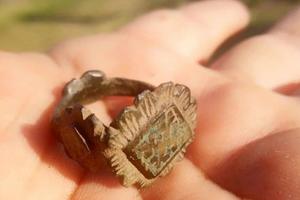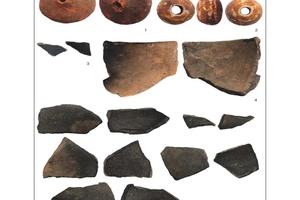Archaeological research at Pustý (Deserted) Castle has been ongoing for 32 years. Every year brings new finds and surprises; the most beautiful this season is a complete women's ring made of brass.
In recent years, they have also found other rare testimonies of life on the highest hill above Zvolen, central Slovakia.
An extraordinary find
"It's an extraordinary find, because they are rarely preserved in their entirety," said Ján Beljak, head of archaeological research, about the ring.
The ring dates back to the beginning of the 14th century. It is an import from French-speaking lands. The luxury jewelry, which was not produced in Hungary at that time, is decorated with crosses on three sides.
On the fourth facet there is a symbolic stylized hand. The crosses are in shields filled with blue enamel.
"We assume that it could have belonged to some noblewoman. Maybe to the wife of the noble man or one of his daughters at the beginning of the 14th century," explained Beljak.
At that time, the Zvolen noblemen from the Balaš family lived in the castle, first Demeter, then his nephew Donč.
A lot of rare finds have already been found at Pustý Castle. "For example, a treasure from the Bronze Age and various jewelry from the High Middle Ages," said the archaeologist.
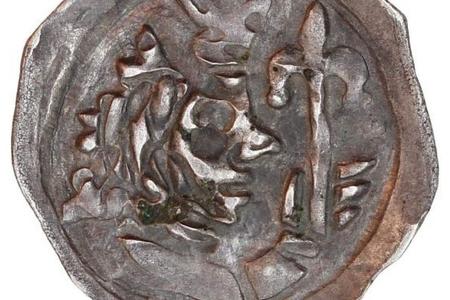
"I always look forward to mediaeval coins, because they have beautiful iconography and at the same time help us to accurately date the locations where they were found, but I still consider the most valuable find the wood from the castle cistern, discovered in 2015. Thanks to the tree rings, using dendrochronology we can accurately date the creation of the cistern to the period after 1294," he explained.
"At the same time, they show us the skill of mediaeval masters. In addition to wood arising from technical construction, we also discovered unique wooden buckets and training swords from that time," he added.
Tower two
The work at Pustý Castle is not only about digging in the ground and looking for the remains of what was hidden for centuries but also the reconstruction of life at the mediaeval castle. Each year they work on salvaging the national cultural monument.
Once popular with Hungarian kings, the place was completely overgrown, with almost no above-ground walls visible. Today, the location almost precisely copies the original buildings.
This season, they restored the tower marked as number two, which is located in the central part of the Upper Castle. The smaller tower built on the top platform of the castle hill represents the additional expansion of the original Upper Castle from the 12th century.
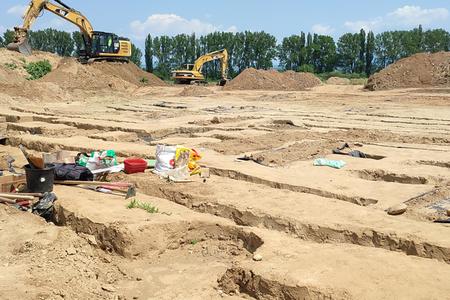
The building, with an external floor plan of 11.2 by 11 metres and a constant wall thickness of two metres, had an original entrance with a width of 0.95 metres in the southern wall.
"It was probably created in the middle of the 13th century and rebuilt at the beginning of the 14th century. At that time, the original entrance to the basement of the tower was walled up and a moat was created, which additionally protected it. It was originally investigated and renewed by the research of Václav Hanuliak in 1994 and 1995," explained Beljak. They restored all the masonry towers and created a protective layer of clay and earth on them.
Most of the finds confirm life in the tower in the second half of the 13th century, such as fragments of pottery vessels from the High Middle Ages, dress fittings, forged iron nails, a smaller number of animal bones and, above all, a mediaeval coin with a poorly preserved coinage, the so far unidentified Vienna Fenig.
©My Zvolen

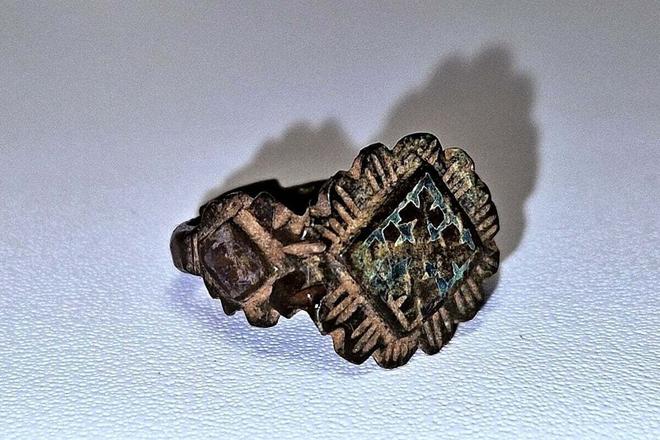 A woman's brass ring found at the Deserted Castle is of French origin. (source: Ján Beljak)
A woman's brass ring found at the Deserted Castle is of French origin. (source: Ján Beljak)
